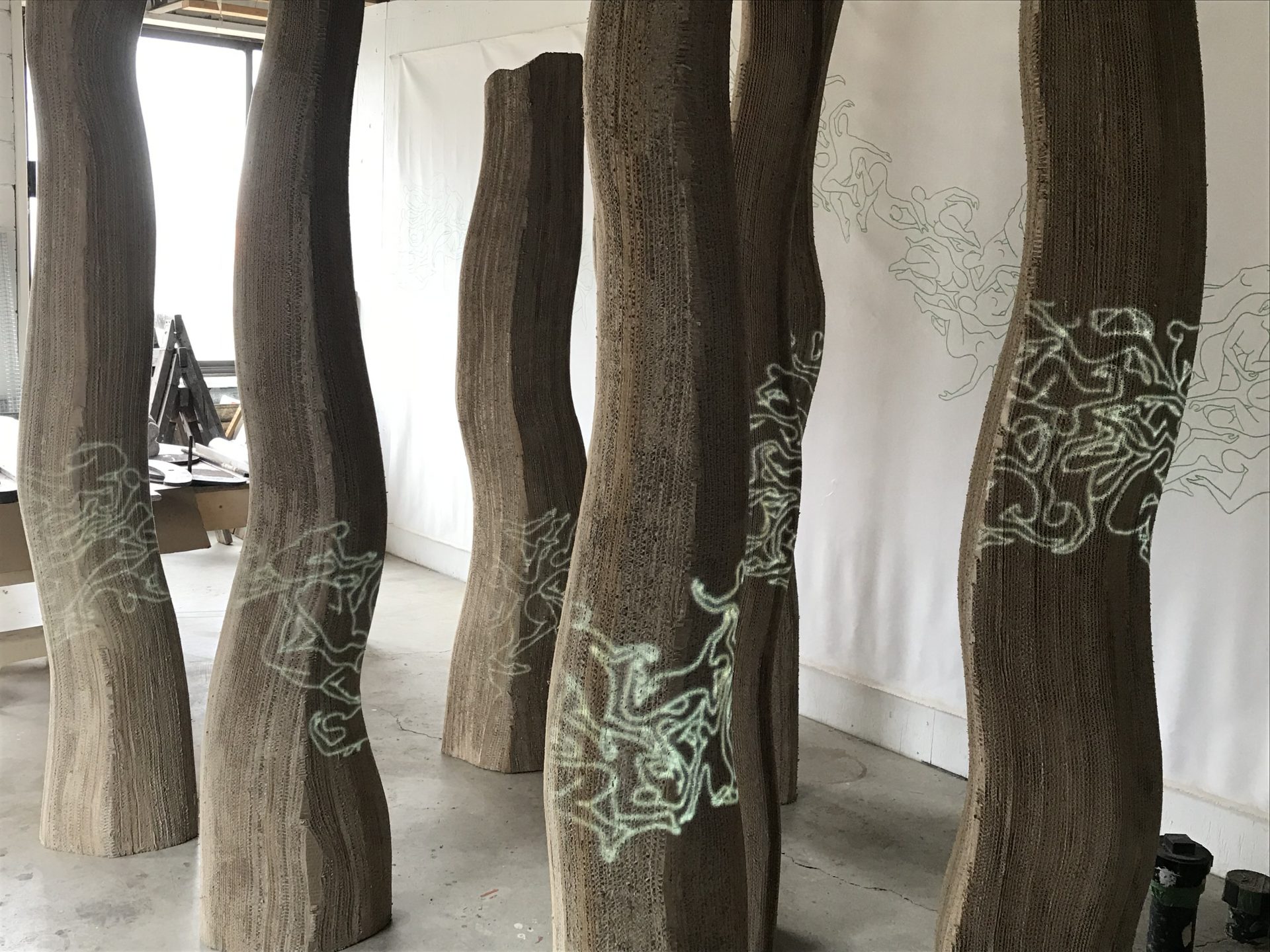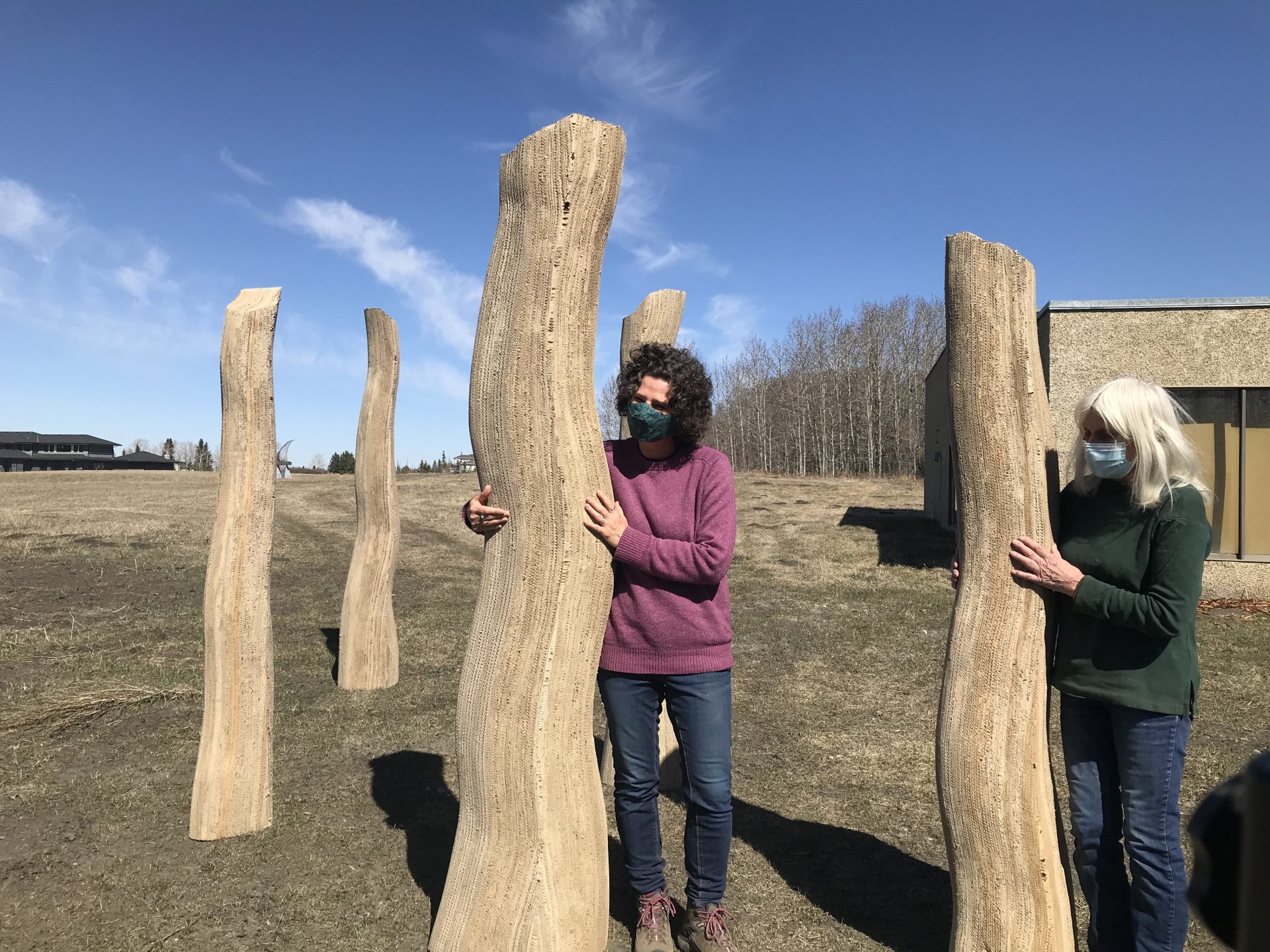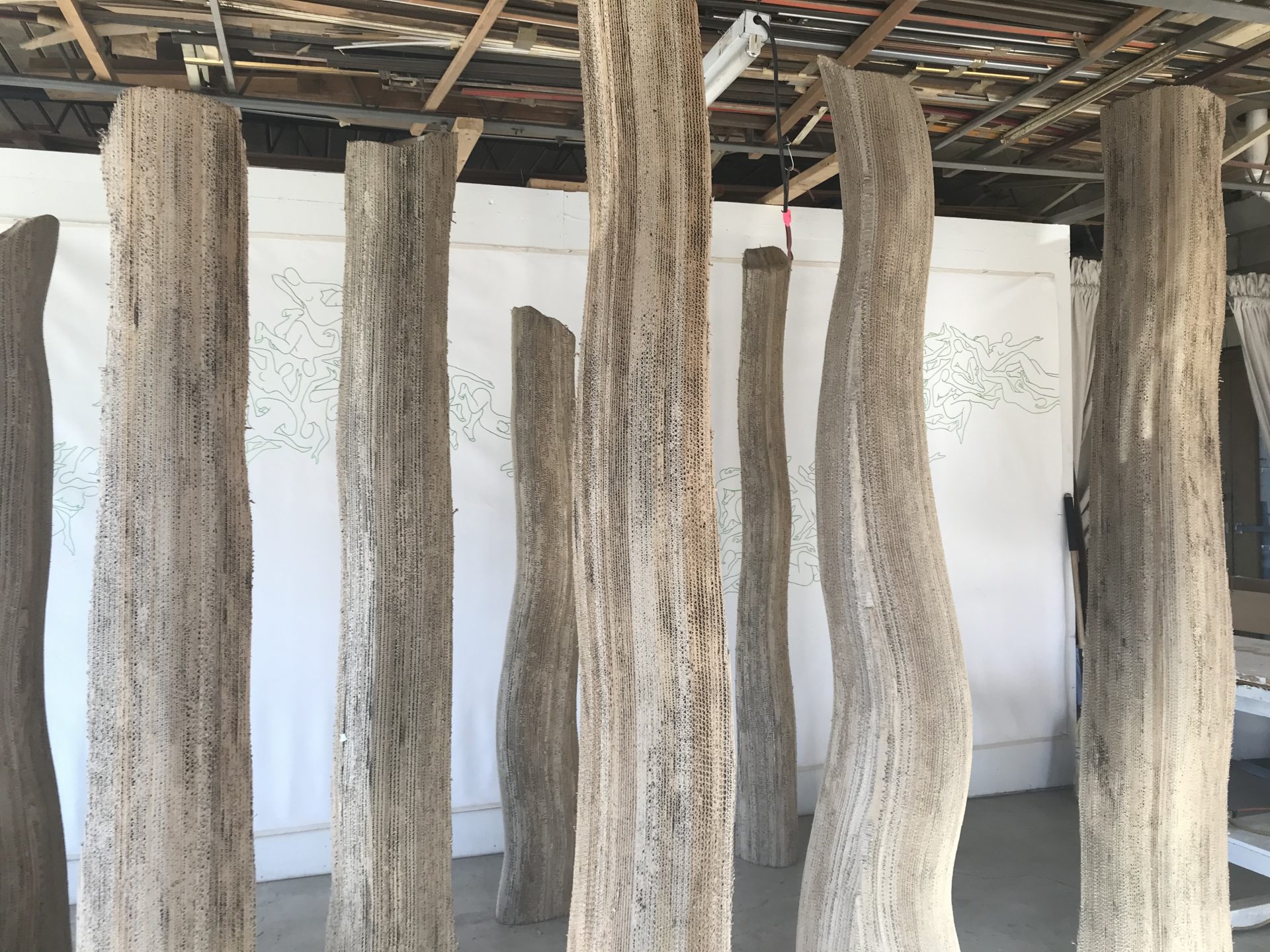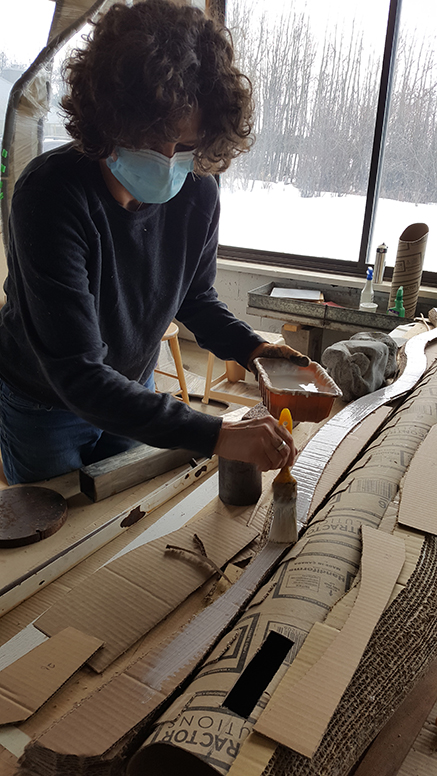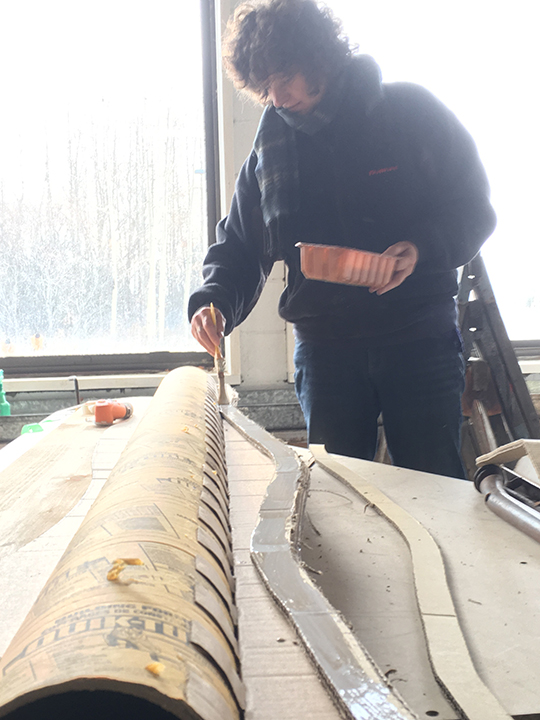Our Artists
Patricia Lortie
Patricia’s playful and intuitive exploration at the KOAC residency space allowed her to find compelling ways to engage with cardboard, a material she collected from alleys and recycling bins. Using volume, mass and shape, and even colour as guiding principles, she successfully reused mostly cardboard boxes beyond their original contexts and uncovered their alternative identities, moulding them into abstract forms beyond their original intent.
As she explains in the videotaped interview with writer Gisèle Villeneuve, the outcome was a sublime sculptural community of “gentle tree-like creatures with personalities of their own that hold secrets we have yet to uncover about our world. As I moulded layer upon layer of cardboard, I got to know each one.” Patricia calls them “The Keepers,” who embody a critical message about climate change, excessive consumption, and environmental pollution. “Like our earthly forests, it feels like my sculptures are keepers of ancient knowledge and infinite potential for life. It feels like they know things we don’t.”
Because of the arrival of Covid, we could not fulfill our intention to have Patricia’s creative process interact with the public. KOAC decided to pair a writer with the artist in residency. We asked Gisèle Villeneuve to produce a piece written on the occasion of Patricia’s work rather than about the artist’s work. Gisèle spent many hours interviewing and observing Patricia’s creative process. She ended up writing an essay that is as much about her practice as a writer as it is about the ideas explored in Patricia’s residency.
Patricia Lortie is a multi-disciplinary Quebec-born artist who moved to Alberta in 2000. She has
been collaborating with KOAC since 2013.
Gisèle Villeneuve is a Calgary-based bilingual writer working in multiple genres and publishing
original works in French and in English.
Ricardo Castillo Arguello, KOAC Executive Director.
INTO THE WOODS: DECODING AN ANCIENT ALPHABET
Musement on Patricia Lortie’s installation
“The Keepers”
Gisèle Villeneuve
Musement is imagination at work,
the wandering mind immersed in the creative process.
Bertrand Gervais,
based on Charles Sanders Peirce’s principle
Faltering at the edge of the text as if faced with untreatable bush. Daunting to dive into the forest, oppressive tangle of shrubs. Patricia also stopped before the idea. Too broad, the idea becomes bushwhacking denying easy passage toward clarity of purpose. Hence the need to go back to the heart of things.
A sculptural installation of cardboard trees, well-spaced for pleasure walking, complete with a video projecting on the trunks outlines of human forms. Those abstract contours suggest the reflecting canopy under a gentle wind and in the play of light. A visual metaphor for self and community, says Patricia.
Both slender and curved, her sculptures fit in naturally with the theme of fluid movement undertaken in her paintings. Figures of humans intertwined in a perpetual vital thrust. Inclined or arched, each silhouette propels itself, so the next one can take its place. The rippling shapes evoke the ruffle of water.
For Patricia, water is as fundamental as nature itself in its entirety. Flushing out memories of childhood. Spring floods near the St. Lawrence River. Cottages built on piles. For hours, canoeing between flooded trees. Garnered ritual that creativity, one day far from the place of origin, brings forth.
Wave and spiral and billow. Sinuous softness permeates sculptures and drawings. Happy days of idleness floating on water allude to the quiet forest, an invitation to slowing down. The art installation, as a map of collective and personal memory; an interaction between the individual and her community. The artist, interpreter of signs.
In the forest, each tree is separate from its neighbours, and yet it is also linked to them through a complex network of nutrients. To understand the forest is an attempt to understand the human experience. For Patricia, trees are the keepers. What are they keeping us from? Perhaps, the illusion our species has of its true autonomy, she observes.
Switching from abstract idea to concrete representation. Searching for the best material and method to construct those arborescent metaphors. Finding the technique, then living with the matter itself. Devising the video to include the large canvas depicting the human
bodies in motion. In the beginning, all is test, reflection, experiment, retreat. Restart.
And so, you enter the studio with a concept and welcome that moment of uncertainty. You hold on to it as long as possible, knowing it is an essential hiatus in the creative process. Similar to the dormant phase of the forest in winter. Waiting for sap rising in the spring. And now, unfolded and simplified, the idea can lead you to the work itself.
The writer too searches for the breach in an idea. How to insinuate herself into the rough text. Unscathed. Like water infiltrating into the soil sustains the entire community of trees. What the mind can insinuate, still doubtful where to go. Stay the course. Willing to risk failure. Try again. Propelled, always, by the imperative impulse to jump higher.
And with Patricia, I step into the studio, that splendid bric-à-brac of the imagination erecting reality. Even when swathed in metaphors. The studio is the jumble of the mind in a creative rush. For the writer at her desk, it’s to collect large and lavish, only to cull later. In pursuit of the how of all things. The anarchy of beginnings.
In the clutter of what’s-to-come-next, that sanctum where memory metamorphoses, the artist collects tools and materials. Material dictates form, she says. Like voice in writing carries the text. From the whims of creativity follows serenity in the act of doing. Tree likeness to evoke an emotion, that of belonging to the world.
Strategies and haptic intervention. The emergence of a method. Patricia values process over result or the finished product. Another way to emphasize the art of doing. And in the painstaking attention to detail, intensive repetition induces a contemplative state. Obsessive, a little out of breath, but oh so vital.
What creatures, alive, hibernating or stuffed, inhabit the deconstruct loft of the writer and her stories reimagining the world? Patricia constructs the overall arc of the installation. The artist in the craft of making. Everyday tasks. Measure, cut, glue sheet after sheet of corrugated cardboard, slowly laminating. A process not unlike the growth rings of trees.
Patricia and her trees. She makes nine of them. An odd number. Playing the odds in art favours harmony. Being an odd-ball in writing means breaking the rules. Shocking maybe, but not a faux pas. To dare. All the more so that the odd number can’t be integrally divisible by two. Even in a species of deciduous trees, each specimen is unique.
Cardboard, exclaims Patricia! But what if this material is unworthy, even stupid? And reject the noble ones, marble or granite, bronze or steel? And even disregard clay or porcelain ennobled by fire? Stroke of genius! Cardboard is made out of recycled paper; the sculptures are constructed with cardboard. Hence, double recycling of material.
Manna: that found object meant to be used only once, then discarded behind shops. The artist and the dumpster, to gather her raw material. Cardboard on its journey: from felled tree to pulp and paper; recycled as art object. Manna: the sweet exudation from the manna ash, which bark strangely resembles Patricia’s sculpted trunks.
To touch the cardboard, rough, yet soft, with gentle hand/Touch – for there is a spirit in the woods, wrote Wordsworth. Longing to understand the process. What lends the striking likeness of bark are the flutes or grooves of each layer of cardboard seen in longitudinal sections. Corrugated cardboard revealed. Full circle of a mutation.
On the construction table, as on the mortuary slab, but in reverse, lies the tree in the making. And contrary to trees fallen in a winter storm, Patricia will raise her tree to exhibit it with the other finished sculptures. So many hours of intimacy spent with each object suggest the slow growth of forests.
In the studio, antechamber to the art gallery, dominates the mess of creation. To sculpt a tree with cardboard, one layer at the time, it is also to write a book, page by page, chapter by chapter. Book ready to be put to bed, tree recumbent, and following a long labour, the writer and the artist launch their works, standing tall, into the world.
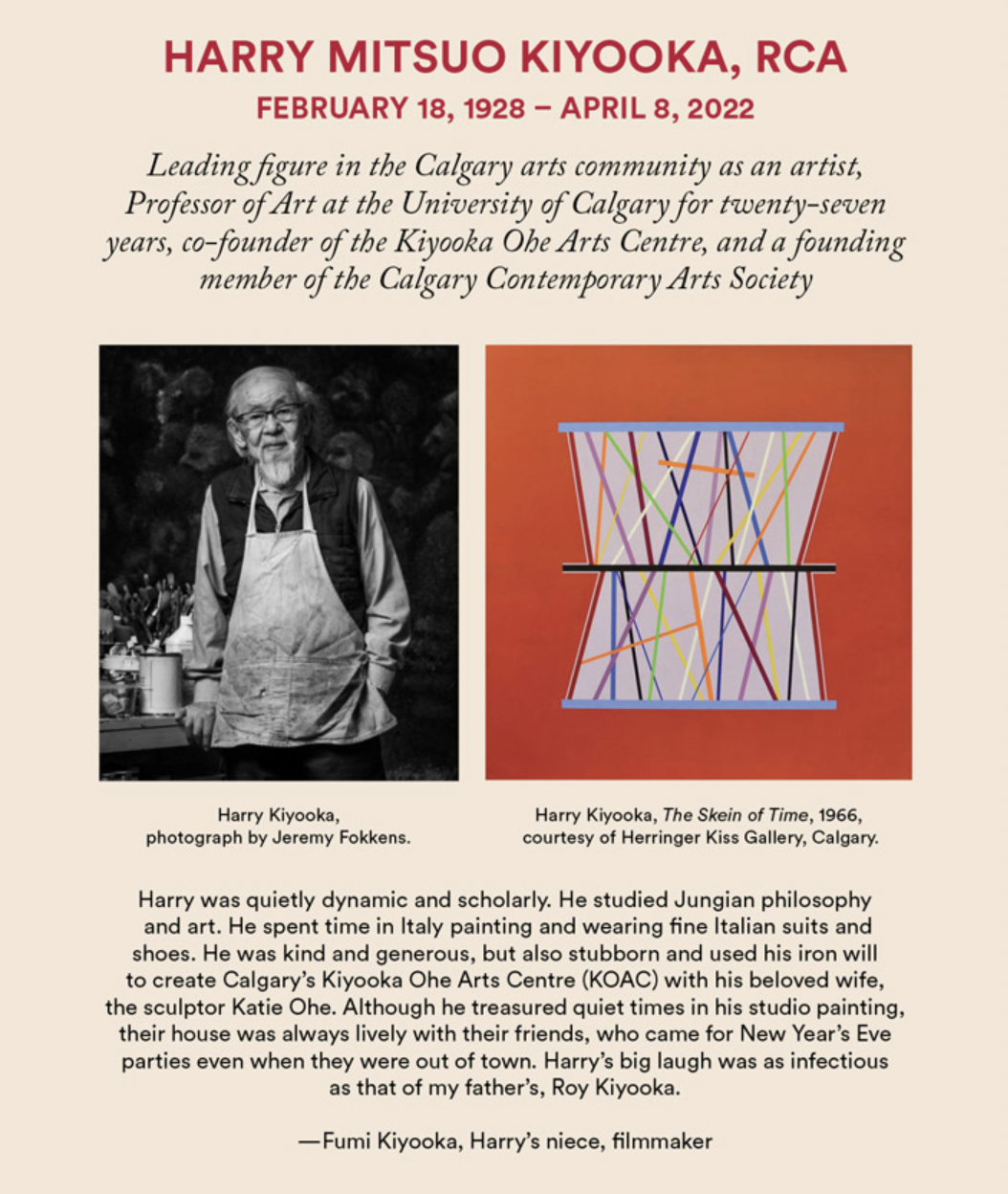
Your generosity is more important than ever
The Kiyooka Ohe Arts Centre is a place for art and artists, for the curious, for the novice and for the expert alike – everyone is welcome to visit, to make, to learn and to talk about contemporary art, whether by traversing our sculpture grounds and gardens, or visiting (when appropriate) with our artists in studio or via our digital forums and workshops.
Regular support from our friends enable us to sustain our work with artists, audiences and communities. Help us keep our grounds open as an escape into Art-in-Nature during this unprecedented time.
Become a member. You can make a difference today. All memberships and donations receive a CRA donation tax receipt.
The KO Arts Centre Society of Calgary is a registered charity. CRA Business Account # 83391 4955 RR001.

